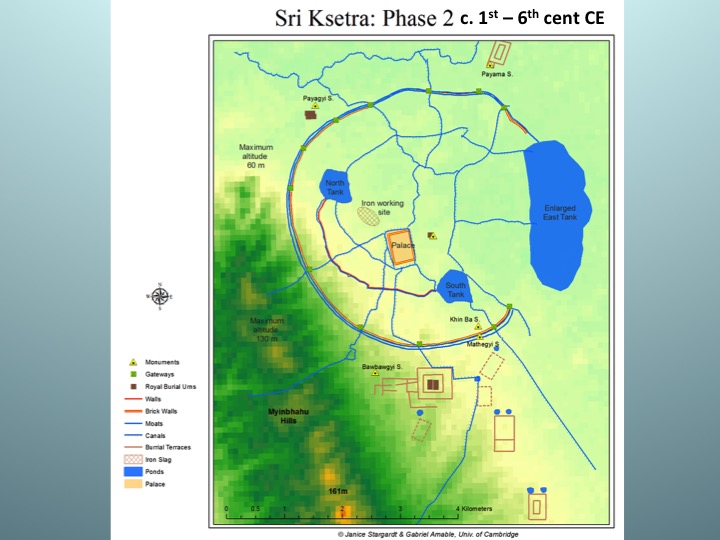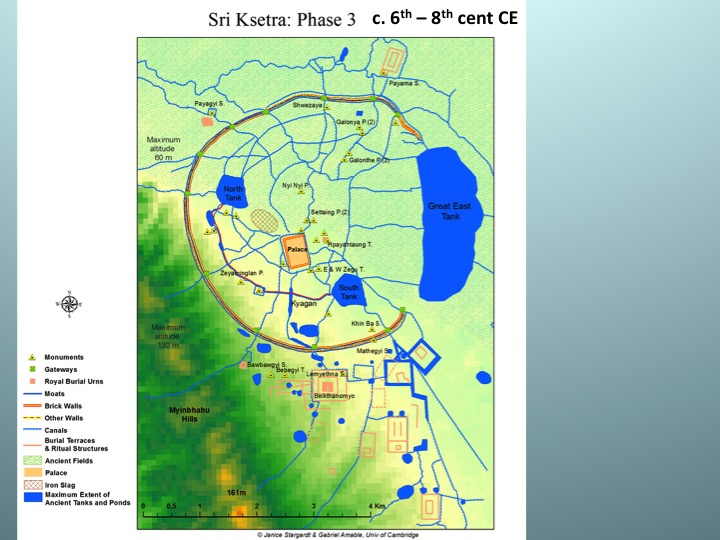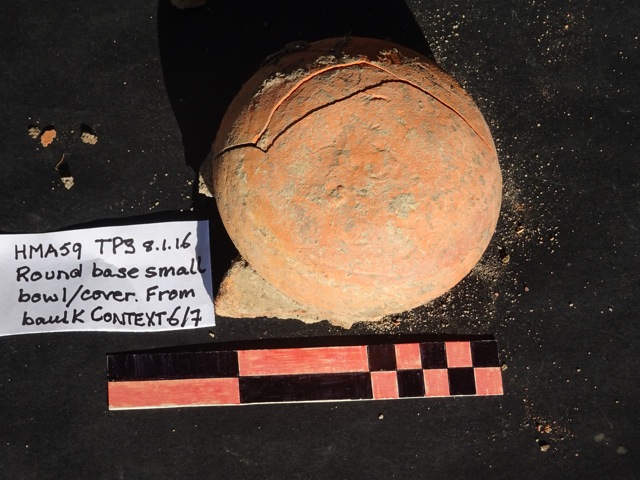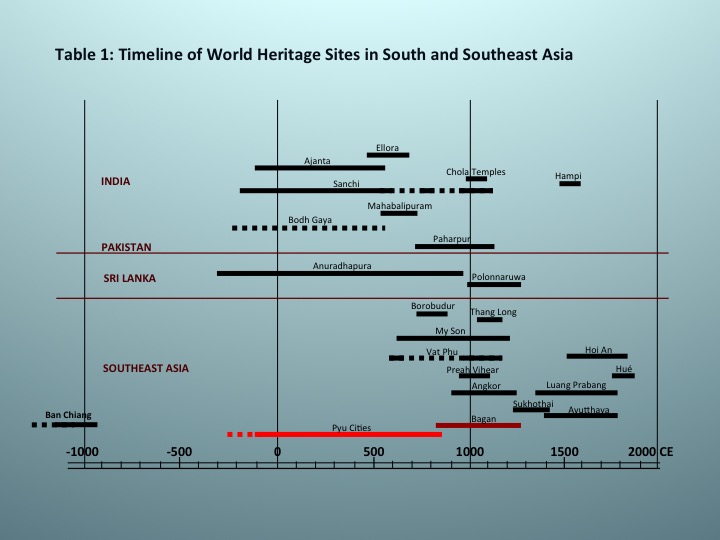
Sri Ksetra, Ancient Pyu City - Director Janice Stargardt
Early Urbanism in Mainland Southeast Asia.
The Sri Ksetra project is concerned with the factors which pushed a relatively small number of sites over the threshold from Iron Age villages into more complex societies in South East Asia in the late first millennium BCE. This problem has not previously been addressed in Myanmar [Burma], yet the earliest urban centres of South East Asia as a whole are the Pyu cities, situated in its great central plains. Sri Ksetra, the main focus of this research project, is the largest and most enduring of the Pyu sites, with the richest assemblage of material culture in the form of fortifications, monuments, sacred art and inscriptions. Part of the Sri Ksetra Project is to explore what the late prehistoric antecedents of early historic Pyu culture were. Viewed in a regional perspective, the Pyu cities share some striking features with a number of later urban sites of mainland South East Asia, such as Danyawadi and Mrauk-U in Arakan, Dvaravati sites in Thailand, Pagan, Angkor and Sukhothai to form an unusual type of urbanism, in that all are situated in the Dry Zones of tropical countries where the rainfall, though abundant elsewhere, is locally insufficient for the cultivation of traditional rices; the sites cover very large, unevenly exploited surface areas which include ancient irrigation and water storage works, fields and gardens among the monumental clusters.
The city of Sri Ksetra has had an iconic importance up to the present in the traditional historiography of Myanmar, and is mentioned in the first millennium records of Thailand, Vietnam and China. Archaeological surveys, limited excavations and conservation works have been undertaken there since the early 20th century, with a primary concentration on inscriptions on stone, metal and terra cotta, and some clearance and conservation on above-ground Buddhist monuments and fortifications made of fired brick. This emphasis changed when Janice Stargardt began field walking and aerial, then satellite surveys at Sri Ksetra, Beikthano and other Pyu period urban landscapes in the 1970s, exploring early urban spaces as dynamic subjects, tracking their changing structures and evolving irrigation systems (The Ancient Pyu of Burma; Early Pyu Cities in a Man-Made Landscape. Cambridge 1990). Her work with members of the Department of Archaeology of Myanmar during four decades helped to establish Sri Ksetra, Halin and Beikthano (the three largest of the Ancient Pyu Cities)as the earliest examples of this first millennium South East Asian type of urbanism, and led to the recognition of their outstanding universal value in June 2014 by inscription on the list of UNESCO World Heritage sites (www.youtube.com/watch?v=4dYf2pJ8BjE ).
Previous archaeological research.
The national Field School of Archaeology of Myanmar, founded in 2007, is located within the ancient walls of Sri Ksetra. This has led to new excavations at Sri Ksetra for field training. Priority has, however, continued to be given to brick structures - monuments and fortifications - now joined by excavations of two brick-and-earth burial terraces outside the southern walls. Up to 2014, 105 monumental structures have been listed inside the city walls, with a further 172 monumental structures outside the city walls, most still unexcavated, and no habitation sites identified and listed.
In October 2014, new surface surveys (Season 1) were carried out at Sri Ksetra by U Win Kyaing, Principal of the Field School of Archaeology, and Janice Stargardt, funded by the McDonald Institute, Cambridge. Their principal aim was to identify possible habitation sites for test digging the following year. On the basis of surface scatters of ceramics and a stratified ceramic sequence exposed in a cutting, two sites were identified, which were then cored down to a depth of 3.70 m, by officers of the Irrigation Department. Promising results were obtained at the Yahanda Mound (c.1.6 ha), just outside the Yahanda Gate (Figure 2b). The extended format of the entire Sri Ksetra urban space comprises c.1,847 ha inside the walls with a further large extra-mural urban area (Figure 3a, b, c). Test areas were therefore prioritised that could potentially contribute to a known urban context. In this case, that context is the partly restored Yahanda defile gateway, whose two massive brick arms extend into the ancient city for 60 m; the remains of two large city walls and traces of two large moats; a small standing brick monument, the Yahanda Gu, or Disciples' Cave, which was inexpertly rebuilt in 1964, but possibly has Pyu origins and some re-use in the Pagan period. 340m to the south lie the two brick-and-earth terraces mentioned above, containing a minimum of 350 and 47 urn burials, respectively, with some simple Buddhist grave offerings. AMS dates of c. 6th and 7th cents exist for these terraces, but it is unclear with what parts or phases of the terraces they are associated.
a. 
b. 
Figure 2a, Location of Sri Ksetra and other Pyu sites in the central plain of Myanmar 2b, Location of the Yahanda mound outside the southern gate at Sri Ksetra
Preliminary Report 2018
Season 2 took place in January-February 2015, as a Cambridge-Field School Joint Project. It comprised three 2 x 2 m test pits on the crest of the Yahanda Mound with a further three 2 x 2 m pits down the eastern slope. The Yahanda mound was designated HMA59. The pits were laid out to investigate traces of ancient habitation, record domestic activities and capture any spatial or typological differences between activities on the crest of the mound and its eastern slope. A second area immediately to the north of the Yahanda Gu was opened to identify the original extent of the brick platform under this man-made cave, explore the possible existence of earlier phases of structural and other activities on the site, and their connection - if any - with finds at HMA59 and a ruined brick platform nearby. This area was designated HMA58. Figure 2b presents the areas excavated in Season 2, January-February 2015, and Season 3, December 2015-February 2016 at both HMA58 and HMA59.
At HMA59 a total of ten 2 x 2 m pits were excavated down to sterile soil while at HMA58 one trench 1 x 13 m and two pits HMA2 and 3 were excavated to sterile soil. The excavations revealed the following results: HMA59 was confirmed as the first habitation site in Myanmar, with a long sequence marking the transition from late prehistory, and important funerary activities through early, mature and declining phases of urbanism. The sequence began with cremated human burials in the basal geological layer of the Yahanda Mound. Twelve cremated burials were found in one pit, HMA59/8/7, the highest of which has an AMS date of 260+/- 30 CE; the lowest dates to c. 1st century BCE. Some locally made ceramic urns from c. 2nd century CE onwards show the influence of Indic ceramic technology but not of Indian religious thought. The dominant ceramic type from the burial phase through to the dealing urban phase in 7th century were paddled wares. Cremation burials of early 5th and later 5th century were found in two further pits. In all cases they were placed directly under wooden floors whose pillars penetrated into the burial terraces of compacted earth (two terraces were faced with bricks). The context immediately above the floor of HMA59 dates to 340+/-30CE. In that context, the first potsherds decorated with Indian motifs sacred to both Buddhism and Hinduism were found, as well as motifs that probably depict scenes from local life (dancing figures and a man racing on a bull). Above this context, the long sequence of hardened work surfaces contained dense deposits from domestic activities, extending continuously from 5th - 7th/8th century. A total of 1.6 tons of ceramics were excavated from the limited sample area (c.150 sq m) of the Yahanda Mound selected for excavation - clear evidence of a high level of human activity, especially from 4th - 6th century CE. Paddled wares were a continuous and dominant type, but the stamped and incised wares were a significant minority. All ceramics have been sorted into broad categories, weighed, counted and photographed. Together with the framework of AMS dates obtained for the main contexts these ceramic data form the basis for the first Ceramic Typology and Chronology in Myanmar, which is now in preparation as part of the Excavation Monograph, to be published in 2019 in the British Museum Research Publications Series (The Yahanda excavations of Seasons 2 and 3 and resulting research and publications were funded by ERC Grant 609823, Asia, Beyond Boundaries...).
An urban space in a dynamic environment
With Dr. Gabriel Amable (Department of Geography), Janice Stargardt has continued to study and map dynamic changes in the environment occurring in the urban area of Sri Ksetra, using a combination of Remote Sensing and ground truthing to identify major phases in its spatial development and the intensification of its irrigation works. The city layout was strongly influenced by its proximity to the Minbahu Range, the local slope factors and seasonal variations in water force resulting from this. Feeder canals, moats, distributary canals, brick walls and storage tanks were developed and modified over centuries to maximise water controls during the rainy season, prevent massive erosion and conduct water safely through distributary canals and moats into storage areas, from which it was further distributed during the dry season. There was a seasonal pulsation to water movement, around the urban space at Sri Ksetra from June to November and through it November/December to May/June. These seasonal rhythms of water contributed to the exceptional longevity and agricultural wealth of the city and basically determined the course of its major walls and moats. Urban spatial organisation became increasingly complex over time, from c. 4th to 8th cent. CE, and included some adjustments to emphasise cosmological symbolism (Figures 3A-C). ('From Iron Age to early city at Sri Ksetra and Beikthano, Myanmar,' Journal of Southeast Asian Studies 47(3), Oct. 2016, pp. 341-365; 'City of the wheel, city of the ancestors:spatial symbolism in a Pyu royal city,' Indo-asiatische Zeitschrift, 6/7, 2002-3, pp. 144-167.
a.

b.
c.
Figure 3A Late Iron Age footprint of Sri Ksetra, 3rd-1st cent. BCE; Figure 3B Parallel development of urban space and works of water control at Sri Ksetra, c. 1st-6th cent. CE; Figure 3C Intensification of water control in urban space at Sri Ksetra c. 6th-8th cent CE
Sri Ksetra: a city of the living and the dead - summary of excavation results 2015-6 (Preliminary Report, 2017).
Excavations at the Yahanda mound, January-February 2015, revealed a long sequence of habitation debris, consisting of dense sherd deposits, food spills and carbonised organic matter. They occurred in a succession of thin, hardened work surfaces, first encountered in Context 5, c. 50cm below the modern surface, and c. 70-80 cm deep in total. Made of clay, mixed with small ceramic fragments, micro-gravel and water to form a marl, they were spread thinly to form horizontal, sun-dried, hard surfaces. The phase of such work surfaces has now been AMS dated from the mid-5th to late-7th cent. CE ("Early urban archaeology in Southeast Asia: the first evidence for a Pyu habitation site at Sri Ksetra, Myanmar.' journal_antiquity_ac_uk_projgall_stargardt348.pdf and Figure 4 below).

Figure 4, Calibrated AMS dates (AD) for the sequence of hardened work surfaces at the Yahanda mound habitation site
Below the hardened surfaces, in Season 3, December 2015-February 2016, another phase was revealed when the traces of ancient wooden floors and wooden post-holes were found both on the crest and the eastern slope of the Yahanda mound. Significant new types of ceramics appeared in the lowest levels of the hardened work surfaces, and were abundant just above the ancient floors. Particularly important in this horizon were well-fired red earthenware sherds, decorated with indic techniques, such as impressed triangles, incised lines, and stamped with sacred indic motifs: the Buddha, lotus petals, human figures wearing heavy armlets and anklets - gods or rulers - and dancers and a few black polished sherds decorated with concentric incised lines (Figure 5 a, b, ). Ceramics of this type were not found below the floors. Finely made red hemispherical bowls appeared with the stamped wares above the floors, but were also found below them (Figure 5c). The earliest phase so far of this habitation site was revealed under four ancient wooden floors, where cremated human burials in urns were found. There, red hemispherical bowls functioned both as lids on small burial urns, and as urns themselves. Some types of heavy, straight-sided decorated ceramics served only as burial urns, while cord-marked sherds - found as domestic wares, both in the hardened work surfaces and just above the wooden floors -- also served as urns in this phase. All urns had originally been placed, without grave offerings, in burial terraces of compacted soils with brick facings. In one part of the eastern slope - TP8 - no fewer than twelve such urn burials were found under one ancient floor, whose post-holes descended among the burials and brick alignments ((Figure 6). The cremated remains in this location reflected a long sequence of funerary activity, occurring in three geological contexts (being dated): in the base layer of pale sand of the mound itself (9), in the succeeding light-coloured silty sand (8) and, above that, mid-brown or mottled silt with some sand (7). All these contexts had been treated with added substances to make them hard and distinct from the natural soils.
a.

b. 
c.
Figure 5a, Yahanda mound, fine red earthenware sherds decorated with indic techniques and motifs (incised lotus petals) found above the wooden floor
Figure 5b, Yahanda mound, fine red earthenware sherds decorated with indic techniques and motifs (heroic or divine human figures) found above the wooden floor
Figure 5c, Yahanda mound, fine red hemispherical bowls found just above and also below the wooden floor, in a funerary context

Figure 6, Yahanda mound, TP8 East section on the eastern slope: context 5, the hardened work surfaces; context 6, the ancient wooden floor and posthole; contexts 7, 8 and 9 geological layers containing a long sequence of 12 cremated urn burials without grave offerings, extending from the base of the mound up to directly under the ancient wooden floor. Brick facings around the burials belong to context 7.
Conclusion
The main results of the excavations at the Yahanda mound to date are to identify three clear cultural phases, embracing ritual funerary activities, succeeded by habitational debris and the first encounters with Buddhism on a popular level. The lowest and earliest phase comprised multiple cremated human burials in ceramic or wood containers without offerings, installed in burial terraces made of compacted soils, some with brick facings. Ancient wooden floors, were constructed on wooden posts directly above the burials. They form the second phase. These floors were covered with traces of domestic activity (numerous cord-marked ceramics providing continuity), but also contained evidence of the first encounters, on a simple popular level, with indic religious culture and indic ceramic techniques, such as rouletting, stamping, concentric lines and Buddhist motifs. These two phases not yet dated but, since they lie below the hardened work surfaces, they are likely to predate the mid-fifth century. Stratigraphic evidence shows that these floors were made of thick wooden planks which rotted in places, allowing clumps of sherds to move into the depressions (Figure 6, downward movements of sherds from context 5 into context 6, especially posthole ), before all the wood disintegrated into dust leaving a context with a distinctive colour and texture. Such processes must reflect the passage of considerable, though at present unmeasured, periods of time between the activities above the floors and the latest of the burials installed under them. The accurate dating of the two lowest phases of HMA59 will not only provide objective dates for those phases, but also, for the first time, date the total span of Pyu ritual and habitational activity at Sri Ksetra. The highest phase - the sequence of hardened work surfaces and domestic debris - has already been reported and dated to the period from the mid- to late first millennium (Figure 4 above).
At the end of Season 2, the January-February 2015 season, one cremated human burial had been found under an ancient floor at HMA59 in TP 4 on the eastern slope of the Yahanda mound. It lay directly under a post-hole. The question was raised in the Antiquity report, whether this association was accidental or deliberate? That question has now been answered by the consistency with which the early Pyu at Sri Ksetra chose to build their houses in places already endowed with significance by clusters of cremated burials. Whereas simple terra cotta Buddhist grave offerings were found in the burial terraces c. 200m south of the Yahanda mound, no such offerings have been found so far among the burials beneath the ancient houses of the Yahanda mound. Their stratigraphy suggests that here the urn burial phase may, therefore, pre-date the early Pyu encounters with Buddhism on a popular level taking place just above the wooden floors. This hypothesis has been confirmed by the latest objective dates obtained by Beta Analystics, who report that the median date of the highest cremation burial is c. 260 +/- 30 CE and the early sherds stamped with Buddhist motifs, found among simple habitation debris just above the wooden floors, date from c. 340 +/- 30 CE. The next step of the Project is to obtain OSL dates for the lowest cremation burials. Samples were obtained by Dr Gabriel Amable during the 4th field season, December 2016-January 2017.
On 1 March 2017, Win Kyaing, Principal of the Field School of Archaeology, Myanmar arrived to spend two months in Cambridge as Charles Wallace (Burma) Visiting Fellow in the Centre of South and Southeast Asian Studies. He is concurrently Visiting Scholar both in Sidney Sussex College and at the McDonald Institute for Archaeological Research. Building on his presence in Cambridge, a Pyu Workshop was held, 3-7 April, in Sidney Sussex College with financial support from the ERC Synergy Grant 609823 Asia, Beyond Boundaries..., a Conference Grant from the McDonald Institute and financial support from Sidney Sussex College. The Pyu Workshop was a unique event in bringing the four senior archaeologists of Myanmar currently working on Pyu sites to Cambridge for the first time, and making specialist discussions possible between them and the UK scholars working on the Sri Ksetra Project. Topics of discussion were, excavations, surveys and mapping, geo-archaeology, Pyu Buddhism and the Pali language, Pyu language decipherment and Pyu comparative linguistics within the Tibeto-Burman language family. The week of intensive interdisciplinary presentations and discussions was very productive; the proceedings are currently being revised for publication.



